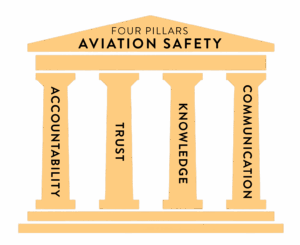By Michael Vanacore-Netz
CEO, Global Air Charters
The Federal Aviation Administration’s upcoming Safety Management System (SMS) mandate for Part 135 air carriers represents more than a regulatory requirement—it’s a recognition that aviation safety in the 21st century demands systematic, proactive approaches to risk management. With mandatory implementation set for March 9, 2027, Part 135 operators have a critical window to transform their safety cultures.
The Legal Framework: SMS Becomes Law
The FAA’s final rule, published in April 2024, marks a watershed moment in business aviation safety. This regulation brings Part 135 operators in line with their Part 121 counterparts and international standards set by the International Civil Aviation Organization (ICAO). The rule requires all Part 135 certificate holders to implement a comprehensive SMS that includes:
- Safety Policy and Objectives – Clear organizational commitment and measurable goals
- Safety Risk Management – Proactive hazard identification and risk assessment processes
- Safety Assurance – Continuous monitoring and measurement of safety performance
- Safety Promotion – Training, communication, and culture-building initiatives
The three-year implementation timeline isn’t generous—it’s necessary. Building an effective SMS requires fundamental changes in organizational structure, processes, and most importantly, culture. At Global Air Charters, we view SMS not as a compliance exercise but as the architecture for building an unshakeable safety culture.
Understanding SMS: More Than a Mandate
 As renowned safety expert Dr. Tony Kern states, “The margin of safety is the difference between what you can do and what you attempt to do.” SMS provides a structured framework for understanding and expanding that margin. For operators of sophisticated aircraft like our Gulfstream fleet, SMS formalizes what the best operators have always done instinctively: constantly questioning, evaluating, and improving safety practices.
As renowned safety expert Dr. Tony Kern states, “The margin of safety is the difference between what you can do and what you attempt to do.” SMS provides a structured framework for understanding and expanding that margin. For operators of sophisticated aircraft like our Gulfstream fleet, SMS formalizes what the best operators have always done instinctively: constantly questioning, evaluating, and improving safety practices.
But SMS is only as effective as the culture that supports it. This is where the four pillars of aviation safety become critical: accountability, trust, knowledge, and communication. These aren’t just abstract concepts—they’re the operational foundation that transforms SMS from paperwork into practice.
Accountability: Ownership at Every Level
True safety accountability means that everyone—from the CEO to the newest line service technician—owns safety outcomes. The legal framework of SMS requires “accountable executives” who have both the responsibility and authority to ensure SMS effectiveness. In our operation, this cascades throughout the organization: – Pilots who speak up about maintenance concerns without fear of schedule pressure – Maintenance teams empowered to ground aircraft when something doesn’t feel right – Leadership that supports conservative decision-making even when it impacts the bottom line – Clear documentation of safety responsibilities in every job description
Accountability isn’t about blame; it’s about creating clear expectations and empowering every team member to be a safety advocate.
Trust: The Foundation of Open Reporting
SMS depends on honest reporting of safety concerns, near-misses, and potential hazards. The regulation specifically requires “a confidential employee reporting system” that protects reporters from retaliation. This only happens in an environment of trust where team members know that reporting issues leads to improvement, not punishment.
“Trust is the glue of life. It’s the foundational principle that holds all relationships,” as Stephen Covey observed.
“At Global Air Charters, we’ve invested years in building this trust, creating confidential reporting systems and celebrating those who identify potential problems before they become actual risks.”
–Michael Vanacore-Netz
Knowledge: Continuous Learning and Improvement
The SMS regulation mandates comprehensive training for all personnel, recognizing that safety knowledge can’t be static. The Gulfstream aircraft we operate represent some of the most advanced technology in aviation. Maintaining safety in these complex systems requires: – Initial and recurrent SMS training for all employees – Regular safety training that goes beyond regulatory minimums – Documentation and sharing of lessons learned across our fleet – Investment in advanced simulation and scenario-based training – Formal mentorship programs that transfer institutional knowledge
Communication: The Vital Link
Perhaps no element is more critical than communication. The SMS rule requires regular safety communication throughout the organization. As Peter Drucker said, “The most important thing in communication is hearing what isn’t said.” Effective safety communication means: – Regular safety briefings that engage rather than lecture – Clear, accessible safety performance metrics – Open channels for questions and concerns – Transparent sharing of safety trends and improvement initiatives – Multi-directional flow of safety information
The Multiplication Effect
When these four pillars work together within an SMS framework, they create a multiplication effect. Accountability drives reporting, trust enables honest communication, knowledge informs better decisions, and communication ensures everyone benefits from collective learning. This is how good operators become excellent, and excellent operators maintain their edge.
The $75,000 to $200,000 estimated implementation cost for SMS may seem substantial, but it pales in comparison to the cost of a single incident—both in human and financial terms. Those who view SMS as merely another regulatory hurdle will miss its true value: a systematic approach to achieving the safety excellence our clients deserve.
In our final article, we’ll examine why passive approaches to safety are no longer acceptable—particularly for the brokers and intermediaries who play a crucial role in connecting clients with operators. The stakes are too high, and the responsibilities too great, for anyone in the aviation ecosystem to remain on the sidelines.
These articles reflect the commitment of Global Air Charters, Inc. to safety leadership in business aviation. For more information about our safety practices, SMS implementation, and operational standards, visit www.gac.aero.
